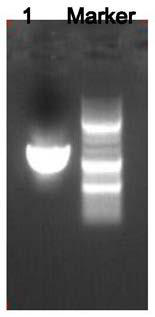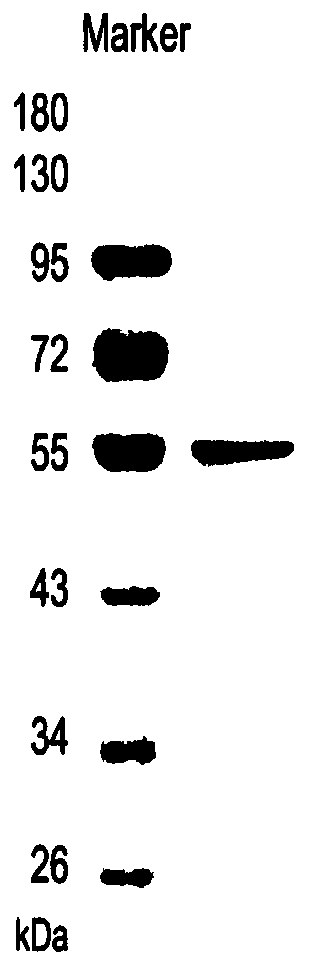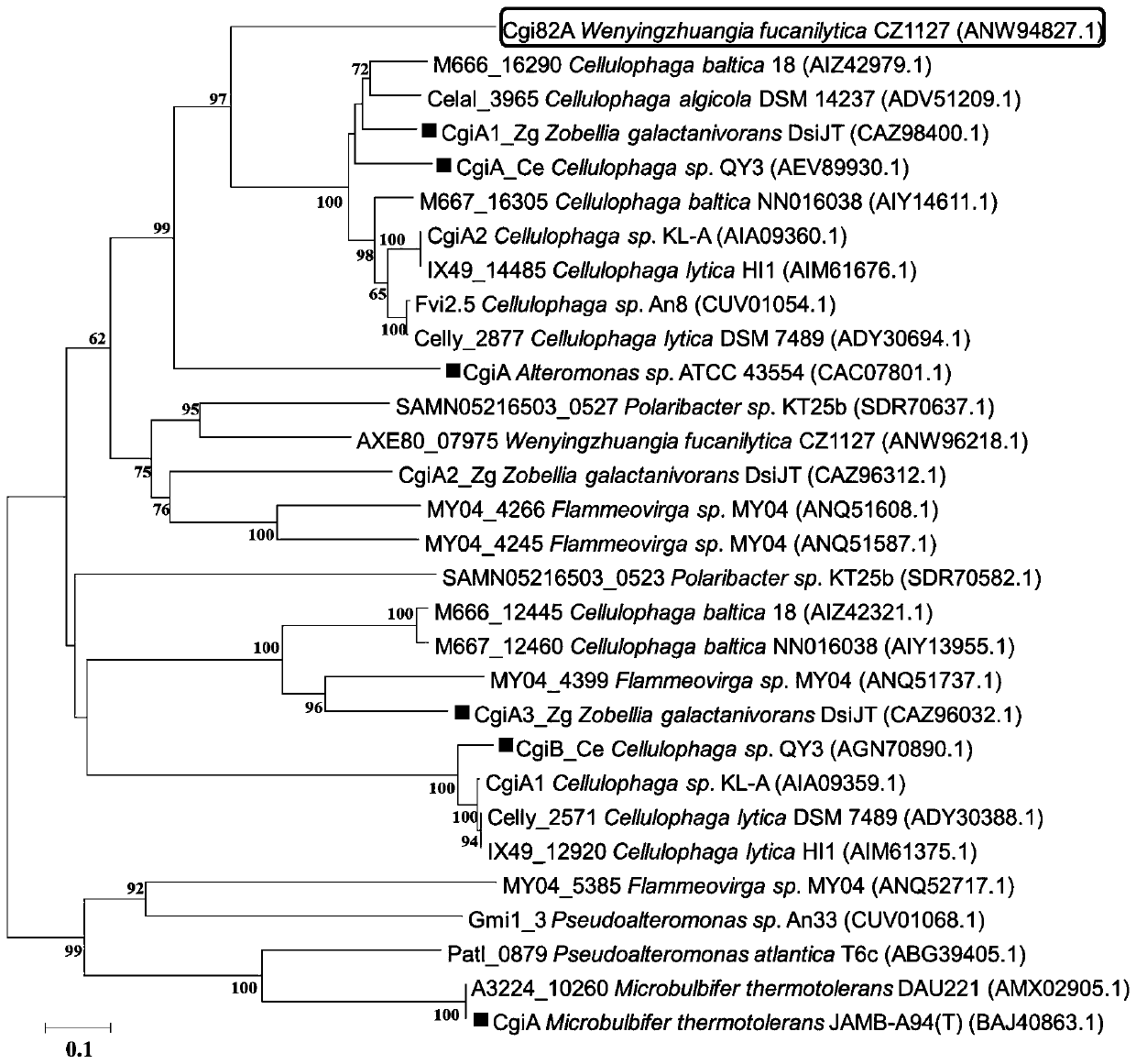Method for quantitatively detecting iota-carrageenan by enzymatic method
A quantitative detection and carrageenan technology, which is applied in the field of biotechnology and biochemical detection, can solve the problems of inability to realize sensitive detection, poor reproducibility, cumbersome operation, etc., and achieve excellent enzymatic properties, high accuracy, and fast enzymatic hydrolysis rate Effect
- Summary
- Abstract
- Description
- Claims
- Application Information
AI Technical Summary
Problems solved by technology
Method used
Image
Examples
Embodiment 1
[0034] Embodiment 1: Cloning expression and acquisition of iota-carrageenase Cgi1_Wf in Escherichia coli
[0035] Cultivation of Wenyingzhuangia fucanilytica CZ1127 in 2216E Medium T Until the end of the logarithm and extract the whole genome DNA, design upstream and downstream primers (5'- GACACGGATCCAAAGACAAAGTAGCAGTAAATGATACTACA; 5'- GACACCTCGAGCTATTGATATACTCTTACATAATCTATTTC) according to the target gene, and use the whole genome as a template for PCR. The PCR reaction conditions are: 95°C for 3min, 94°C for 30s, 58°C for 30s, 72°C for 150s, 22 cycles, and finally 72°C for 5 minutes to obtain the iota-carrageenase Cgi1_Wf gene fragment, which was connected to the DH5α vector to form a recombinant plasmid. The recombinant plasmids were introduced into BL21(DE3) competent cells to form recombinant strains. The expression was induced by isopropylthiogalactoside in LB medium containing kanamycin, the induction temperature was 17°C, and the induction time was 12h. Collect the ...
Embodiment 2
[0037] Embodiment 2: Cloning expression and acquisition of iota-carrageenase Cgi1_Wf in Bacillus subtilis
[0038] Cultivation of Wenyingzhuangia fucanilytica CZ1127 in 2216E Medium TUntil the end of the logarithm and extract the whole genome DNA, design upstream and downstream primers (5'-GGCTAATGGGCAGCAGCCATCATCA; 5'-AATGAATTATGTAAGAGTATATCAATAG according to the target gene, use the whole genome as a template to carry out PCR as in Example 1, and obtain the ι-carrageenase Cgi1_Wf gene fragment, Connect to the pHT01 vector to form a recombinant plasmid. Transform the recombinant plasmid into Bacillus subtilis competent cells, screen positive clones and use isopropylthiogalactoside to induce expression in LB culture medium. The induction temperature is 38°C. The induction time is 14h. Collect the bacteria by centrifugation and add a certain amount of 20mM Na 2 HPO 4 -NaH 2 PO 4 Suspension in the buffer solution, and then ultrasonic crushing in an ice-water bath (power 400W...
Embodiment 3
[0039] Embodiment 3: Cloning expression and acquisition of iota-carrageenase Cgi1_Wf in Pichia pastoris
[0040] Cultivation of Wenyingzhuangia fucanilytica CZ1127 in 2216E Medium T Until the end of the logarithm and extract the whole genome DNA, design upstream and downstream primers (5'-TTATAAATGGGCAGCAGCCATCATCA; 5'-GCATGCAGATTATGTAAGAGTATATCAATAG) according to the target gene, and use the whole genome as a template to perform PCR as in Example 1 to obtain the iota-carrageenase Cgi1_Wf gene fragment , connected to the pPIC9k vector to form a recombinant plasmid, which was added to Pichia pastoris GS115 competent cells to form a recombinant cell; positive clones were screened and inoculated in YPD medium, cultured at 30°C for 20h, and then inoculated in BMGY medium, 30°C, Cultivate on a shaking table at 200 rpm until OD600 = 2.0, collect the bacteria by centrifugation, discard the supernatant, resuspend the pellet with BMMY medium, and induce culture with methanol at 200 rpm...
PUM
 Login to View More
Login to View More Abstract
Description
Claims
Application Information
 Login to View More
Login to View More - R&D
- Intellectual Property
- Life Sciences
- Materials
- Tech Scout
- Unparalleled Data Quality
- Higher Quality Content
- 60% Fewer Hallucinations
Browse by: Latest US Patents, China's latest patents, Technical Efficacy Thesaurus, Application Domain, Technology Topic, Popular Technical Reports.
© 2025 PatSnap. All rights reserved.Legal|Privacy policy|Modern Slavery Act Transparency Statement|Sitemap|About US| Contact US: help@patsnap.com



